Off-Page SEO: Understanding the Trinity of Optimizations Pt. 2
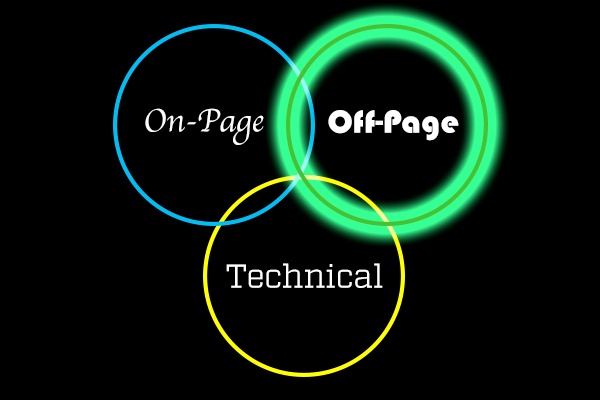
In modern SEO, game-changing updates to Google’s algorithm such as Penguin and Panda have solidified off-page SEO as the king of optimizations, reigning over on-page and technical.
SEO software company SearchMetrics provides a solid definition of off-page SEO:
“all the measures that can be taken outside of the actual website in order to improve its position in search rankings. These are measures that help create as many high-quality backlinks (incoming links) as possible.”
They nail the most critical component of off-page SEO in that definition – “high-quality backlinks”.
In this post I will explore the concepts of backlinks/authority, show how to identify backlink opportunities, and share outreach strategies as they relate to off-page optimizations and provide you with tools and techniques to get started optimizing on your own.
What Are Backlinks and Why Should I Care?
Backlinks are simply another term for hyperlinks on other websites that point to web pages on your site. They are also interchangeably referred to as inbound links.
In March of this year Google let the proverbial cat out of the bag and straight up said that links were the #1 or #2 most important factor in their ranking algorithm.
However, this admission mostly confirmed what industry experts have hypothesized for a while.
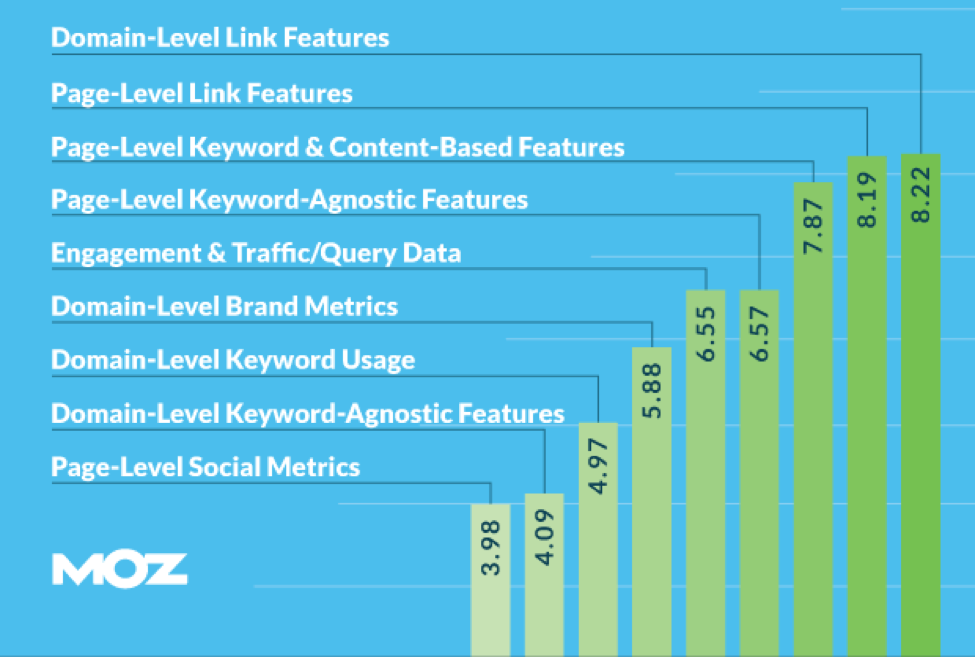
Source: Moz’s Search Engine Ranking Factors 2015 Report
So if the search engines themselves and SEO experts agree that links are very important, it begs the question, why?
It all boils down to authority.
Domain and Page Authority – Measures of Trust
The internet is a wide world full of everything from inspiring, insightful, and invaluable content to spam so dangerous that your computer could become part of a hacker’s botnet swarm simply by visiting a webpage!
Because of this nature, it’s critical for search engines to understand what websites can be trusted to provide quality content and a friendly user experience in a safe environment.
One tell-tale signal of a website’s quality and trustworthiness is how many other quality and trustworthy websites link to them. I like to think of links as similar to personal endorsements.
If you have links to your site coming from credible sources like established industry blogs, .edu domains, or major news outlets, search engines know that they can safely direct users to your website with confidence that the content you are providing will be valuable to them.
Ultimately the number and quality of links pointing to a site or page culminate in values known as Domain Authority (DA) and Page Authority (PA). In general, the higher DA and PA of a site or page, the better chance a given page has to rank highly in search results.
Respect My Authoritah!

Source: southpark.cc.com
Software providers such as Moz and Ahrefs provide proprietary measures of these metrics that go under different names. Moz calls it DA/PA, Ahrefs calls it Domain Rating/URL Rating.
Although they go under different names, each of these metrics quantifies the same the concept: a website or a web page's authority.
If you’re interested in finding out the DA and PA’s of your website (as you should be), I encourage you to try out Moz’s Open Web Explorer tool by:
- Heading over to the tool’s web page
- Copy pasting the URL you want to check into the search bar
- Viewing the DA and PA results!
You’ll get a results page with information like this:

The relationship between DA and PA is fairly straightforward. Backlinks pointing to a page increase that page’s PA, and also increase the overall domain’s DA. This overall increase in DA is then spread to other pages via internal linking like we discussed in part one of this series.
The authority granted by links is often colloquially known as “link juice”, which is an appropriate name because it’s easy to conceptualize authority and its flow around a website as liquid:
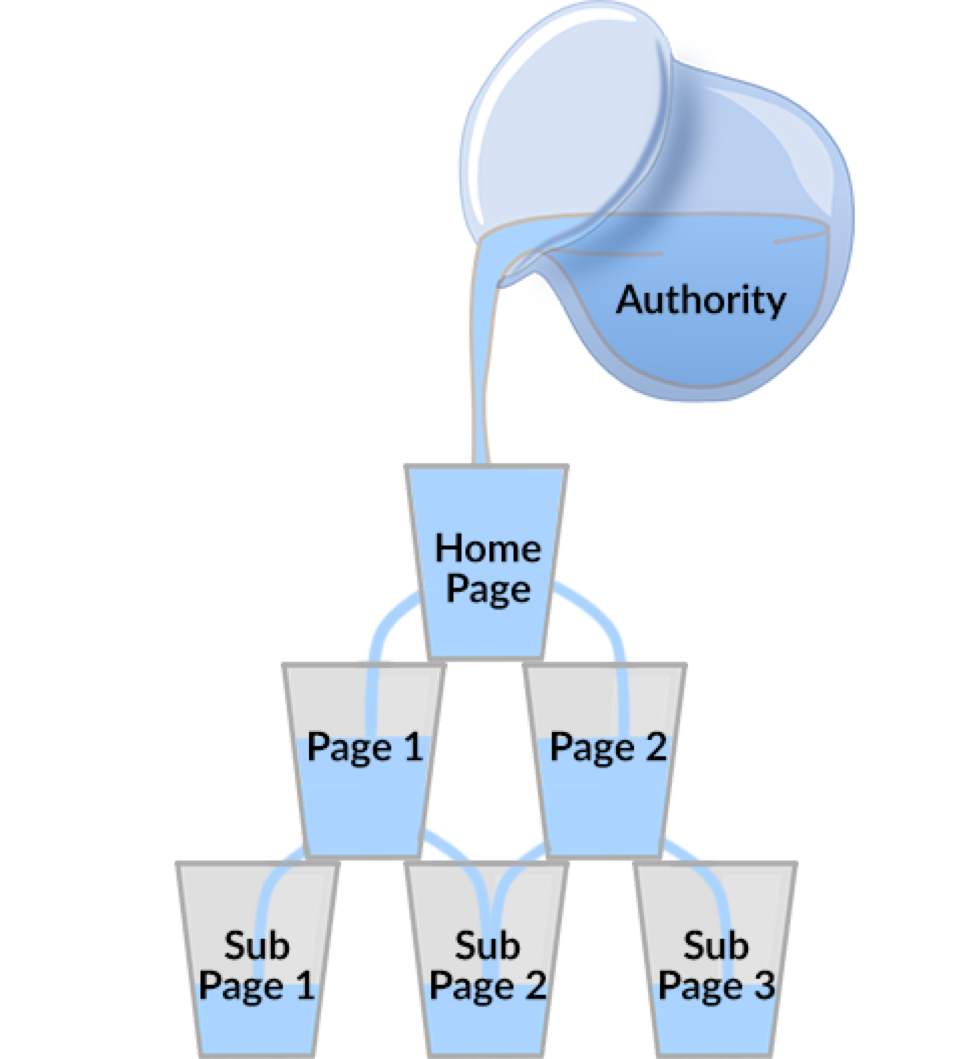
Sure, nobody would ever buy glasses with holes like that, but you get the point!
The cumulative authority earned by inbound links is spread from page to page and flows around the website through internal links. Typically, the homepage has the highest PA, but that’s not always the case.
Not All Backlinks Are Created Equal
There is an important distinction to understand when seeking to acquire or analyze backlinks: the difference between “follow” links and “no follow links”.
The primary difference from a search perspective is that no follow links instruct search engines not to take them into account when calculating search results.
But, you might be wondering, why do no follow links even exist then?
The answer is unfortunately: spam.
In the olden days, less reputable SEOs would flood blog posts with comments to earn valuable backlinks to their client’s websites. Once search engines caught onto this and the no follow HTML tag was introduced, the tactic became useless and webmasters no longer had to worry about their comments sections being overrun by spam.
To quickly determine if the link you’re looking at is a follow or no follow link, right click on the web page in your browser and select the “Inspect Element” option. Then hover over your link and if you can find the rel=”nofollow” like below. If it’s there you’ve got a no follow link on your hands.

Now that we’ve covered the concept of authority and explored backlinks, how should you go about getting backlinks and growing your authority?
How to Identify Backlink Opportunities
In my opinion, one of the great myths in digital marketing is the notion that “if you create unique, high-quality content, backlinks will come naturally”.
That might be true if you run an already authoritative site with a substantial dedicated following, but that’s just not the reality for most marketers.
Earning backlinks to your content largely boils down to your hustle in promoting your content to the people running relevant websites in your industry. The first step to identifying backlink opportunities is knowing what you’re looking for.
A Backlink Match Made in Heaven
In general, an ideal opportunity for backlink outreach will have three identifiable qualities:
- A demonstrated interest in the topic of your content
- A demonstrated willingness to share 3rd party content
- A Respectable DA/PA
People are much more likely to be open to sharing or linking to your content if it is relevant to their interests and the interests of their audience.
If you notice that the website you would like to get a link from has authors who put links to external resources in their articles, it’s a good sign your content can find its way onto their site.
Some websites do not link externally as a matter of policy, and some sites do link externally but automatically apply a no follow tag. It’s worth checking through the method above to see if a prospective link would end up being no followed before you pursue it.
Lastly, a DA/PA higher than your own is a positive indicator that this is a link opportunity you should pursue. Links from lower authority sites won’t necessarily hurt you (unless there A LOT from shady or irrelevant websites), but considering the DA/PA of your target certainly helps you prioritize your outreach efforts.
Finding Backlink Opportunities with Google Search
This is definitely the easiest method for finding backlink opportunities. Simply head to Google and search for some of the keywords related to your topic and look through the first three pages of results and put the websites that fit the criteria above in an excel spreadsheet.
Key information you may want to record includes the website’s URL, the title of the site, DA/PA, the topic they most closely relate to, and an author or webmaster’s Twitter handle (and/or email) for future outreach.
Here’s a sample of a spreadsheet I put together recently while performing backlink research:

While you’re looking through the search results you’re bound to run into your competition. After all, your competitors are likely producing content around similar keywords and topics and you can be sure they’re not going to hand a backlink out to you. But, you should still record them in your spreadsheet for a reason we’ll cover in a moment.
There are several types of websites you will want to keep an eye out for in the search results:
- Neutral Publications – These are websites in your industry that create and share content about your topic, but do not actively compete against you to provide the products or services you do. In the SEO world, two examples are Search Engine Watch and Search Engine Journal.
- Individual Bloggers – These are people who may be running their blog as a hobby, or as thought leaders. Since they are in the content creation game in your industry and are probably not direct competitors, they are a good target. Again looking at the SEO world, two of the most prolific players are Neil Patel and Brian Dean.
- Non-Competing Companies – I’ve often found you will often see rankings from companies that do something related to what you do, but are not direct competitors. A perfect example of this is when you work at a service company and see software companies in the listings. For my agency, it might make sense to reach out to Moz or HubSpot, because they provide marketing software and we use it!
Finding Backlink Opportunities Through Backlink Analysis
Once you’ve begun building your list of websites from search results, you can take your research a step further by looking at the websites that link to the websites you want to link to.
If you plug the URL of one of your target websites into a tool like Moz’s Open Site Explorer or Ahrefs (if you have a paid subscription), you can get a list of all of the websites that link to your target website.
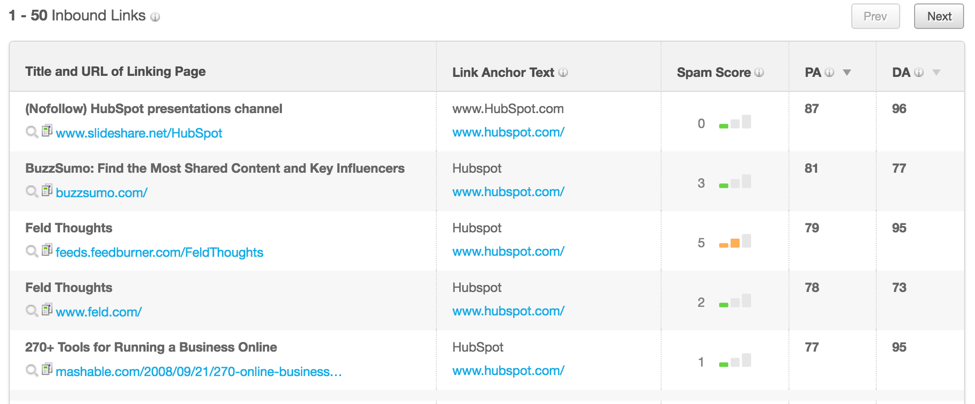
Moz’s tool provides a list like this.
Look through the list of websites provided by your backlink tool and add any sites to your list that meet your criteria and might make sense to reach out to.
You will also want to point this tool at the competitors in your list so that you can reverse engineer their backlink profile and develop an understanding of what sites and backlinks are pushing their content onto the first page.
You can perform this method as many steps down the chain as you’d like, but you should have a decent sized list of targets by the time you examine the backlink profiles of the first group you identified in Google search.
Finding Backlink Opportunities on Social Media
Scouring social media can surface opportunities for backlinks that you never would have found on Google search or through a backlink tool.
Twitter is going to be your best friend for finding backlink opportunities because it is massive, publicly searchable (which means tools can look into it), and uses hashtags.
A tool like BuzzSumo is perfectly suited for identifying backlink opportunities. This tool allows you to search for the top performing content on social media by keyword, or by domain.
If you searched for the keyword “ppc advertising”, you’d get a results page that looks like this:

BuzzSumo tracks how the content at that url has been interacted with on social media and the feature you will want to leverage next is the ability to “View Sharers”. If you have a paid version or free trial this will allow you to see who on twitter has shared this url.
This is invaluable because somebody who shares content related to your keyword is also likely to be open to sharing and/or linking to your content!
Outside of using a social media tool like BuzzSumo, a good old fashioned hashtag search on Twitter is likely to net you the accounts of people who share content in your industry.
When you search for a hashtag, make note of people who are sharing content in the results and add them to your outreach list. Even if they do not have a website to link to you from, they might still be open to sharing your content with their audience, and some of those folks may run websites to link from.
How to Approach and Pitch Backlink Opportunities
When you’re reaching out to a backlink opportunity, it’s important to keep several things in mind:
- These people likely receive requests like yours all the time.
- They likely understand backlinking is providing something of value.
- Fundamentally, you’re establishing a relationship with another person.
With all of that in mind, I’m going to share three avenues at your disposal for approaching the people and websites on your opportunity list in pursuit of the cherished backlink.
Direct Email
Many bloggers openly list their email addresses on their website for people to be able to get in touch with them. If you have a personal email address for somebody on your opportunity list, the most effective outreach method is to email them directly.
But not just any email will do, an outreach email to an influencer in your industry should adopt a specific form and specific characteristics.
Your outreach emails should be:
- Short and sweet – these are busy people you’re sending to, and it’s to your advantage to intelligently, eloquently, and succinctly explain who you are and what you want. As a rule of thumb, try to keep your initial outreach email under 150 words.
- Personalized – because these people receive so many pitches, you need yours to stand out. One of the best ways to do this is to demonstrate a personal relationship with their content. Maybe mention that you’re a long-time fan of their blog, or namedrop a recent article of theirs that really stood out to you.
- Nuanced – Coming straight out and saying that you’re asking for a backlink probably won’t get you far. These influencers seek to provide value to their audiences, and if you approach the outreach from the angle of adding value to their content, you’re going to get a better response.
Here’s an actual email outreach example from digital marketing expert Gregory Ciotti:
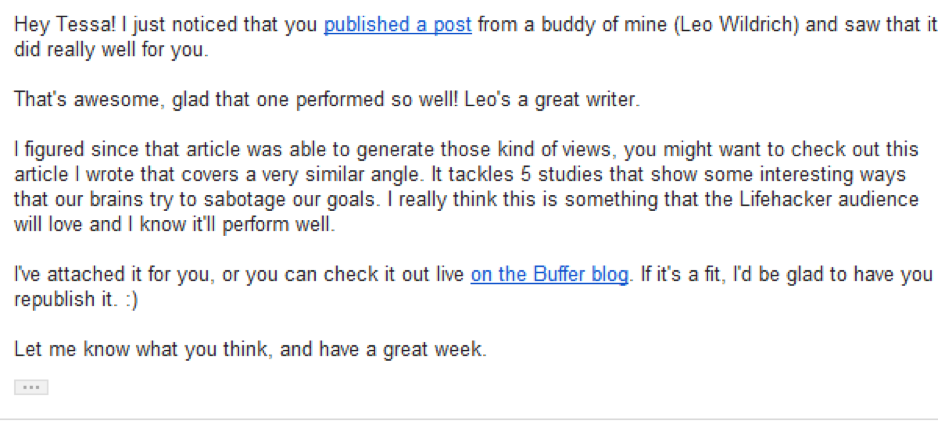
Notice how he keeps the email short and to the point?
Gregory was fortunate enough to have a personal connection with another article’s author (Leo), and parlayed that into a connection with the person he sent the email to.
Lastly, he does not come out and say “can you please put this article on your website so I can have a link back to mine?” Instead, he speaks to the value he believes his article will provide to the webmaster’s audience, and you can bet that article includes links to the pages he wants to boost.
Social Media Outreach
Social media also offers chances to engage in personal conversations with influencers and develop relationships that can open the doors to many backlink opportunities.
You should follow the thought leaders in your industry on social media and see what they are talking about and respond to their social media activity. If they share an article on Twitter, don’t be afraid to comment back with what you thought about it. After all, they are sharing content on social media with the express purpose of generating engagement.
Sometimes these thought leaders ask questions to their audience and you might be able to respond with an answer that includes content you want to promote. They may even ask their audience to point them to fresh and high quality content!
Lastly, social media has a secret weapon to add to your outreach arsenal: the Direct Message.
Direct messaging (or DM’ing) allows you to engage with other users in a private, 1-1 forum. Facebook, Twitter, and LinkedIn all support DM’s and if you are having trouble finding the email address of your backlink opportunity, why not send them a DM with the same message?
Direct Message notifications show up separately from other notifications on social media profiles and so a message sent there has a solid chance of being seen.
Community Participation
The last method for outreach that you can take advantage of is what I’m broadly terming “community participation”.
The people on your backlink opportunity list have spent lots of time carefully cultivating their online communities and by joining in and adding value to their community, you can develop powerful and lasting relationships on the road to backlink acquisition.
One of the most tangible ways to do this is by becoming active in the comments section of their blog posts. After they publish a new post you could provide your two cents on the article. You could also look for unanswered questions or offer fresh perspective to the comments made by others on older posts.
Again, much of the reason these thought leaders create content and curate communities around it is to spark conversation and generate engagement. By participating in their communities, you are increasing the value of being a member of that community and putting yourself on the radar of the website owner.
What’s Next?
Thanks for tuning in to another installment of my Trinity of Optimizations series! I hope you enjoyed the read and can apply some of the learnings in this article to your own content promotion efforts.
Now that we’ve discussed on-page SEO and off-page SEO, it’s time to take a look under the hood and see what behind-the-scenes aspects of SEO can help you achieve coveted first page rankings.
In part three I explore the ins and outs of Technical SEO. Let me know what you think of this post and I’ll see you in the next!
About Author
Andrew Sober
Stay up to date.
Subscribe for periodic updates on the latest happenings in life science and healthcare marketing.
Subscribe Here!
Related Posts
Ingenuity is about being clever, original, and inventive. It means finding a way to accomplish your goals
BY Andrew Sober
The opinions expressed in this blog post are not legal ...
BY Andrew Sober
Paid advertising is the most immediate lever you can pu...

Comments